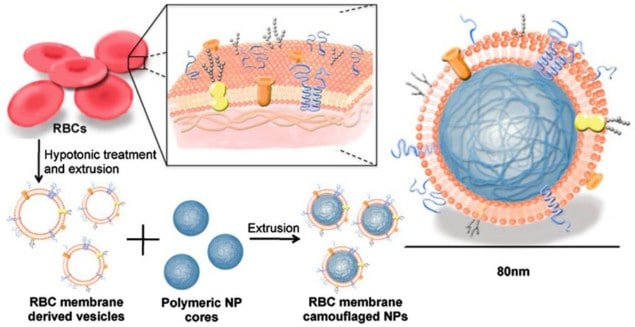
Nanoparticles disguised as red blood cells could be used to deliver anti-cancer drugs directly to a tumour. So say researchers at the University of California at San Diego, whose new technique is unique in its approach to harnessing nanoparticles.
Drug delivery systems that mimic naturally occurring biological molecules seem to be the most efficient when it comes to delivering drugs to tumours. Such systems – usually based on nanoparticles – can also circulate in the body for extended periods of time without being rejected by the body’s immune system.
Cocktail of anti-cancer drugs
The new method invented by Liangfang Zhang and colleagues involves exploiting the cell membrane of a red blood cell. The researchers wrap the membrane around a biodegradable polymer nanoparticle that is around 100 nm in size and which has been filled with a cocktail of anti-cancer drugs. This is the first time that scientists have combined a natural cell membrane with a synthetic nanoparticle for drug-delivery applications, explained Zhang. “Such a nanoparticle platform will have little risk of immune response,” he said.
Such “stealth” nanoparticles, as they are called, have already been used with success in clinical cancer trials to deliver chemotherapy drugs. However, previous studies looked at nanoparticles coated with synthetic materials like polyethylene glycol (PEG) – the current gold standard in the field. These coatings protect the drugs contained inside the nanoparticles. If they weren’t protected, the nanoparticles would rapidly induce an immune system response in the body. The coatings allow the particles to circulate in the body for longer, giving them time to deliver their drug payload.
Cloak tricks the body
Zhang and colleagues’ strategy lies in another direction altogether – it involves using a naturally occurring membrane rather than a synthetic one. Such an approach avoids having to build a system that exactly mimics all the biological functions on the surface of a cell. A nanoparticle with a red blood cell membrane “cloak” tricks the body because it looks just like a real red blood cell to all intents and purposes, says Zhang.
Preliminary experiments by the team show that nanoparticles coated with a red blood cell membrane were able to safely stay inside the bodies of laboratory mice for as long as nearly 72 hours.
The researchers say that they would now like to be able to produce their biomimetic nanoparticles in larger quantities for future clinical trials. They also plan to add a targeting molecule to the red blood cell membranes so that the particles can seek out and bind to specific types of cancer cell.
The work was reported in PNAS.



